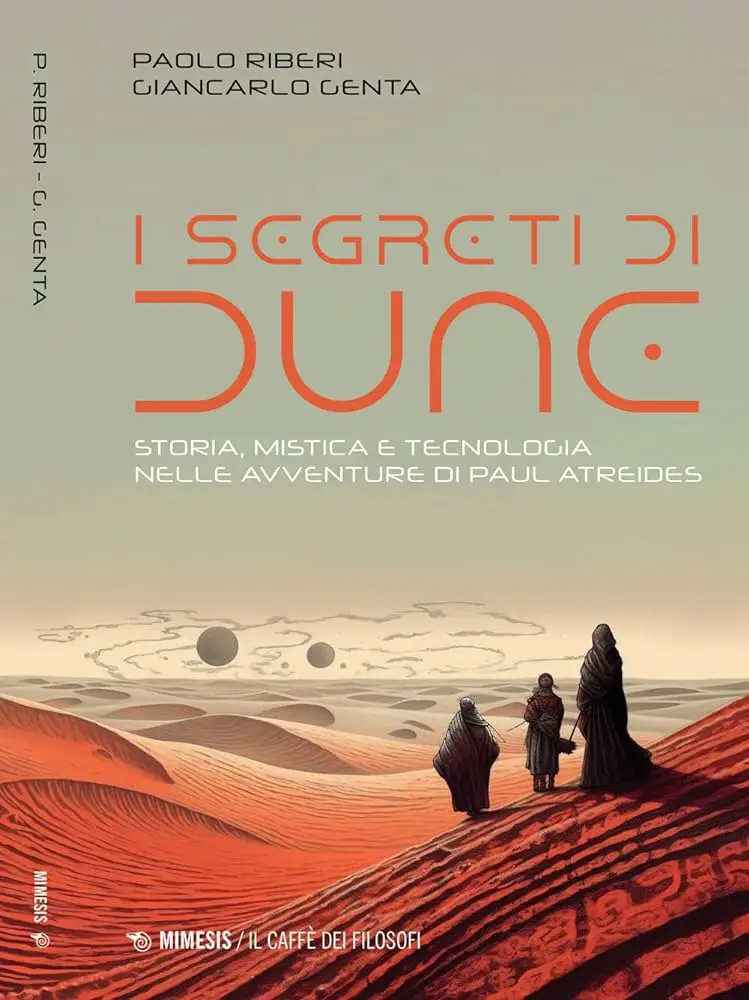In a dark and oppressive cosmos like that of Dune, , among the sands of Arrakis lies the only element capable not only of giving political power over the entire universe, but also of opening a glimpse into the ultimate meaning of time and life. This element is Spice. Compared with Secrets of Dune by Riberi and Genta, we will analyze the sacred role of Spice, at the basis of the mysticism and religion of the Fremen people.
di Daniel Palmieri
After three years of incubation from previous article on esotericism by Dune, , I return to reflect on the immense universe generated by Frank Herbert, on the occasion of two concurrent events: the release in cinemas of the second part of the film shot by Denis Villeneuve and the publication of the text Secrets of Dune (Mimesis 2024), co-written by Paolo Riberi and Giancarlo Genta, which gives me the opportunity to delve deeper into some topics that I had left unanswered.
Secrets of Dune it is without a doubt one of the most in-depth studies in Italian on the world created by the pen of Frank Herbert. . The text is a comprehensive overview of every aspect of the author's literary saga, which then extends to Villeneuve's cinematic universe and David Lynch's first experiment. The book analyzes every detail in which Herbert's monumental work branches out, from politics to geography, from technology to the habits and customs of the populations, up to a detailed cartography of the inhabited worlds beyond the atmosphere of Dune and the complex geopolitical plots that involve them. Not being able to dwell on all these aspects, in this article I intend to address a particularly important theme analyzed in the text, which acts as a common thread throughout the entire Dune work: that of Fremen mystique and theirs sacral-religious rebellion.
The sacred and the mystical in Dune,
The theme is addressed by Riberi and Genta in the fourth chapter, The sacred and the mystical in Dune. As the authors also point out, the question is the central pivot around which the entire saga revolves, the point of convergence where the political games, present and past, and the long-term projects of the Bene Gesserit meet, the cosmic dominion of the Emperor, the power plots of the Harkonnens, the geological transmutation of Dune, the control of the Spice and, last but not least, the visions, dreams, of Paul Atreides and the “grafted” prophecies (as we will see) in the Fremen which will take unexpected and uncontrollable consequences.
The complex and controversial religious inspiration that permeates the entire cycle of Dune, it is so important that, as Riberi and Genta point out, Herbert himself
he defined the Duneverse the work of one spiritual melting pot, that is, a bubbling spiritual cauldron in which different religious traditions coexist. The definition is more fitting than ever: the entire universe of Dune, it is pervaded by the theme of the sacred.
[1]
As analyzed in previous article, and how the authors deal with it in greater depth in the chapter Before Dune: Artificial Intelligence, the religiosity that permeates the cosmic Imperium is a direct consequence of Butlerian Jihad, during which human beings rebelled against the domination of machines and artificial intelligence, reaffirming the centrality and powers of the human mind through the development of extrasensory - or, it would be more correct to say, "supersensory" faculties.
However, this development occurred in two directions; in fact we have the exoteric doctrine, aimed at the masses, systematized and dogmatized in the so-called Catholic Orangutan Bible, which places the sacredness and uniqueness of the human mind at the center by placing restrictions on the development of artificial intelligence, a divine law which, like the precepts of the tables of the law, provides "negative" prescriptions; and, in the shadows, a doctrine or, better yet, an esoteric practice, dedicated to initiates of secret orders who plot plots in the world, linked to the development of psychic powers through spiritual and mental exercises. As Riberi and Genta write:
Frank Herbert's veiled criticism of the interference of the Jesuit confessors of the seventeenth century is quite evident, but the theme is also part of a much larger political-religious system, which is very similar to that of ancient Rome between the late republic and the early imperial age. At the time, the pagan office of Pontifex Maximus was universally considered a simple stage in the political career that led to the consulate and could also be held by characters [...] who were considered far from any religious sentiment. Ultimately […] the Bene Gesserit order and the Orange Catholic Bible of Dune, they are mere expressions of a state religion which only serves to legitimize the political order of the Imperium [...] the sphere of religion is always considered by all the characters in the saga [...] as a mere political and social superstructure, a construction ideological that only serves to support the authority of those who sit on the throne.
[2]
A control which, however, at a certain point escapes the controllers themselves; and here another form of religiosity comes into play: that of the Fremen.

I fremen: the concealment in the cave
The boiling of the second epochal event of the epic of Dune, takes place within the population of the newly oppressed: the Fremen. Genta and Riberi precisely reconstruct the myriad of reference points that Herbert took inspiration from to create the complex Fremen society, in which nothing is left to chance: politics, social organization, habits and customs, religion, are all described in such detail from Herbert to be rendered Dune, a true treatise on anthropology and sociology. As the authors point out, in the culture of this population they converge Jewish overtones, especially with regards to the struggle against imperial power, the strong messianic fervor and the dream of a verdant Promised Land, but above all the Arab-Muslim culture, both radical Islam and esoteric Sufi currents. Genta and Riberi write:
The contrast it is not between a presumed moderate Islam and an extremist Islam, but rather between an esoteric and spiritual Islam with ancient medieval roots and a new generation fundamentalist and literalist Islam.
[3A]
Added to this is the influence of
proud and bellicose deeds of Sunni Islamic populations of the Caucasus in the mid-nineteenth century, who from 1829 to 1859 waged a holy war - or jihad - to repel the invasion of a gigantic foreign empire intent on using their lands as a commercial and military viaticum to reach the riches of the East: the Russia of the tsars.
[3B]
Real Mujahideen of the desert, with entirely blue eyes, transmuted by addiction to the spice - reminiscent of the blue clothes of the Tuareg or the blue eyes of the Berbers - the Fremen have perfectly adapted to Dune's many hostilities and live in perfect symbiosis with the desert. To adapt to the water shortage, they have developed sophisticated stillsuits that recycle every liquid in the body. To survive the scorching desert, but also the ferocity of the Harkonnen, they live in underground countries called Sietch, and move mainly at night. In order not to attract the Sand Worms, immense beings that roam the desert dunes swallowing everything they encounter, they have developed a step with an asynchronous rhythm, which recalls the movements of sand moved by the wind - which makes each of their movements similar to a natural change . Their ethics have become as rigid as the conditions of the planet, and yet there is a rigor and coherence in them that leaves Duncan Idaho, the explorer sent by the Atreides to study their customs, in admiration; it is precisely their system of ethical-religious rules that makes the population cohesive, combative and unbeatable, hardened by years of battles with the desert and with the terrible Harkonnen.
The latter, in fact, have established an oppressive dominion over the entire planet. Interested in squeezing the Spice down to the last handful of powder, the Harkonnen repress with blood any attempt at rebellion by the Fremen, who they consider and treat like beasts.
As mentioned above, there is a religious spirit that hovers throughout the novel and even the Fremen, with their culture, are no different and, indeed, embody the purest and most fanatical aspect of religious yearning at the same time.

In this context, the Fremen represent a mysterious reality, which cannot be framed in the established cosmic order. Although, as Riberi and Genta argue, the messianic inspiration of the Fremen is conditioned by the invisible hand of the Bene Gesserit, there is a fighting spirit in their people which following the Butlerian Jihad has allowed them to maintain partial autonomy, thanks to the hostile climate of Dune and their concealment underground which preserved them from the all-encompassing influence of Imperial religion. Unlike the masses, in fact, they have not been conditioned by the "negative" precepts of the Orangist Catholic Bible and like the Bene Gesserit they possess an ascetic lifestyle, necessary to survive the harshness of the desert, rituals dedicated to initiates and psychedelic ceremonies linked to expansion of consciousness.
Their lifestyle is outdated; it is not devoted to economy and trade, but to symbiosis with the surrounding environment, as well as to a perpetual war against the invaders who are disfiguring their planet. No one really knows their way of life.
The Harkonnen consider them brutish and underdeveloped, but they cannot explain how they can survive in such a hostile environment with rudimentary equipment; and, most importantly, they ignore their real number. How to jin of the desert, they appear directly from the sand – an aspect masterfully rendered by Villeneuve's film adaptation.
Their elusiveness is linked to the myth of the concealment of civilization. As already mentioned, the Fremen live in the Sietch, "Place where we gather in times of danger”, according to their language, caves and underground tunnels, with a strong symbolic charge. Since ancient times, the cave is the border place between two worlds, the material world and the invisible world, which holds within itself the secret of Creation. As, for example, Porfirio writes The cave of the nymphs:
The ancients conveniently consecrated the caves and caves of the world, considered both in its totality and in its parts, attributing to the earth the symbol of the matter of which the world is composed; therefore some also inferred that the earth was matter, and that the caves meant that the world comes from matter. Since caves generally form spontaneously and are congenital to the earth, enclosed in a uniform rock, concave on the inside, they push outwards towards the indefinite space of the earth.
[4]
La relationship between the cave and sacredness it is also found in the Islamic world, whose culture is clearly inspired by the Fremen population. There Sura of the Cave it is one of the Suras that most stimulated the religious imagination of mystics. It narrates the underground hiding of a group of saints who took refuge from the world, which closely resembles the warrior hiding of the Fremen in the underground world of the Sietch. As stated in the Koran:
Do you not know perhaps, Mohammad, that the Cave People and their scrolls were the best of Our Signs, a true marvel among the Believers. When those young men took refuge in the cave, they turned to Us and prayed to Us: O God! Grant us Your Mercy and let us always walk on the Straight Path. And we put them into a sleep that lasted many years.
[5]
A myth, that of civilization relegated to an underground world awaiting the advent of the Golden Age, recurring in various traditions, as analyzed by René Guenon The King of the World [6], which gives life and, above all, the Fremen revolt with a mystical charge that cannot leave readers helpless. And the religiosity of the Fremen is always linked to the chthonic world, first of all with the cult of the Worms of the Sands.

Shai Hulud and the psychedelic Eucharist
I Sand Worms they are venerated by the Fremen as deities. They are called "Creators", emissaries of the worm-god Shai Hulud:
The Sand Worm of Arrakis, the Old Man of the Desert, the Old Father of Eternity, the Grandfather of the Desert. This name, pronounced with a certain tone or written with a capital letter, designates the earthly deity of Fremen family superstitions.
[7]
This veneration is not only a form of primitive religion, linked to a form of primordial animism, but is closely linked to the symbiotic relationship between the Sand Worms and the planet Dune. In fact, it is the Worms, with their incessant action, that shred everything that passes through their enormous jaws. The infinite expanse of dunes is therefore the work of their perpetual wandering under the sands of the desert; but the matter that flows through their body, in addition to being reduced to dust, also undergoes a true alchemical transmutation which gives life to the most precious element of Dune: Spice. It is the Worms that produce the red spice with psychedelic effects that sprinkles the entire planet. Hence the relationship of terror and veneration established with the native populations.
As mentioned previously, the majesty of the universe created by Herbert lies precisely in the accuracy of the details, be they religious, social, anthropological or ecological and even in this case the author's intuition is no different. L'action of the enormous Worms that populate Dune is nothing other than the re-proposal, on a large scale, of what really happens on our planet, in the microcosm of the underground soil. As Darwin writes in his The action of worms:
Worms have played a role in world history that is more important than most people might assume. They are extraordinarily numerous in almost all countries with a humid climate and despite their size they have great muscular strength. In many parts of England more than 10 tons of dry earth per acre of land passes annually through their bodies and is brought back to the surface, so that the entire surface layer of topsoil passes through their bodies in a few years. Through these expedients, always fresh surfaces of the soil are continuously exposed to the action of carbonic acid and humus acids, which appear to be even more effective than the decomposition of rocks. […] When we contemplate a large expanse of grass, we should remember that its regularity, which plays so much part in its beauty, is mainly due to the fact that all the unevennesses have been smoothed out by worms; it is extraordinary to think that all the surface soil in any lawn has passed, and will pass again, within a few years through the bodies of worms.
[8]
For this reason, even in the Dune universe, the Sand Worms are called "Creators"; theirs is not a simple symbiosis with the planet: it is they who co-create the atmospheric and physical conditions of Arrakis, not only by incessantly grinding everything they encounter and producing the Spice, but also relegating the water - which for them is a deadly poison – in caves and underground wells.

As Riberi and Genta also write:
Compared to the benevolent Father God of the three great monotheistic religions, the Shai-Hulud of Dune represents an authentic "Anti-God", which radically overturns and revolutionizes every characteristic [...]. Shai-Hulud is not a spiritual, celestial entity, but rather a physical monster that dwells underground. He is not a mortal and omniscient god, but an animal driven by pure instinct, devoid of awareness and with a well-defined biological cycle. He is not a ruler who dwells in a verdant garden, but a parasite who generates the surrounding desert. He is not even a paternal and benign creator, but rather a threatening entity who simply leads his own existence without caring about the fate of humanity.
[9]
Together with the Worms, water and Spice are the other two elements sacred to the Fremen, also, we will see, linked to the underground world and with a close mutual relationship. Water is the most precious element for the Fremen and, within the community, it is even used as a currency of exchange. Thanks to the precise construction of the Dune ecosystem and the description of its arid hills, Herbert managed to bring to light the vital and sacred importance of water precisely by virtue of its absence. Immersing yourself in the hell of Arrakis and then returning to the real world, the reader will not be able to look with the same eyes at the superabundance that hides in a simple mountain stream. Likewise, water, for the Fremen, is not a simple element linked to bodily survival. A real religious asceticism has developed around water, the Discipline of Water: self-control of the body and emotions so that, not even by crying, a single drop of water can be wasted.
It represents a sacred entity, the very source of life and the element of cohesion of the entire group. Water is the vital, universal spirit that unites each member of the Sietch, as evidenced by the saying: "The flesh belongs to the deceased, but his water to the entire tribe", linked to the funeral ritual with which the Fremen separate the body fluids of the dead to return them to the entire group. A custom that is not linked exclusively to the recycling of a sacred element, but which takes on a meaning similar to what was theorized by some Cynic and Stoic philosophers of antiquity, for whom the cannibalism of the deceased would represent a ritual to assimilate the essence of 'ancestor and thus prevent its extinction [10].
The most precious sources of this element are found hidden in underground wells, where the water is accumulated by "wind traps", on which some Sietch arise, whose mystical atmosphere recalls sacred places such as Nuragic Wells of Sardinia, as evidenced by the mystical tone with which they are presented to us by Herbert when, for the first time, Paul is admitted to one of them:
Paul felt the steps beneath his feet, curving downward to the left. The yellow light danced over the hooded heads as the Fremen spiraled downward and downward […]. The steps ended and the group went through another door. The light from the luminous globe was dispersed in an immense underground cavity with a very high domed ceiling. […] In this cathedral atmosphere, created by the dripping of water, an absolute immobility seemed to take hold of the Fremen. I saw this place in a dream, Paul thought.
[11]
It is no coincidence that a mystical ceremony, with a Dionysian character, is linked to these wells, the creation of the so-called Water of Life:
one of the enlightened poisons. In particular, the liquid secreted by a Sand Worm at the moment of his death by drowning. In the body of a Reverend Mother it transforms into the narcotic that causes the Sietch's tau orgy. A psychotropic drug that has the effect of extending the perceptual spectrum.
[12]

If Spice is the most common drug spread among the population, there is however a mystery psychedelic agent, dedicated exclusively to the Reverend Mothers initiated into the Fremen mysticism, the Water of Life, precisely. Like Spice, it too is produced by the Sand Worms and represents an even more powerful form of poison, which only the initiatory training of the Bene Gesserit can make tolerable to the body, to cancel the poisonous effects and amplify the psychedelic ones. Herbert writes, to describe the effects of the Water of Life:
Silence swirled around Jessica, every fiber of her body having accepted the profound transformation taking place within her. You seem to be a tiny speck of conscious dust, smaller than any subatomic particle and yet capable of moving and perceiving the world around you. Her veil was torn and she suddenly became aware of a psychic, sensorial and motor extension of herself. […] Inside her the drug was a whirlwind of dancing particles, so fast that not even the stopping of time could stop them.
[13]
As Genta and Riberi write:
Just like the Persian haoma, the Spice and the Water of Life are substances with mystical and healing properties, which, on the one hand, refine the individual's senses to the point of leading him to the threshold of the alam al-mithal and, on the other, they give your organism a much longer life than normal.
[14A]
But most of all,
This is a crucial element in the narrative economy of the Dune saga, where the Spice of Arrakis represents the only genuinely sacred element in the universe: upon closer inspection, during the adventures of Paul Atreides, the powers of the drug, produced by Shai Hulud, I am the only true supernatural entity that is not the result of religious engineering and genetic manipulation!
[14B]
In addition to the words of the authors I would underline how, despite the Bene Gesserit education allowing one to withstand the heroic dose of Spice and survive the ceremony, albeit after days of apparent death which has much in common not only with shamanic initiations but, above all, of extremely demanding psychedelic rituals such as those linked to the Iboga cult, the content of the visions given by Spezia is one of the few moments in which Paul seems to savor a metaphysical knowledge, an authentic revelation or religious sensation that transcends all the plots of power and which they put him in contact with the very secret of the universe. Herbert writes in what, in my opinion, is one of the most powerful passages in Herbert's entire work:
Paul, in the shadow of the cave, was next to Chani: he could still taste the food she had given him: bird meat and wheat mixed with spice honey and wrapped in a leaf [...]. He knew that that spice essence would transform him even more, making him more and more of a Seer. […] Paul breathed deeply, trying to calm the inner storm. […]. He sensed it. That racial consciousness which he could not escape. That sharp mind of his, that flow of information, that cold, precise awareness. He slipped to the ground, leaning against a rock, abandoning himself to that sensation. Awareness flowed into that still layer from which he could contemplate time, perceive the paths open before him, the currents of the future, and those of the past: past, present and future seen with one eye, three images combined in a three-dimensional vision , as if time had become space. There was a danger, he could feel it, of going too far. He had to desperately cling to the present, while his experience of it was increasingly confused and distorted, in the continuous flow of each moment, and in the consolidation of what is in the perpetual has been. For the first time, clinging to the present, he perceived the monumental regularity of the movement of time, complicated everywhere by eddies, waves, ebbs and flows; the continuous foaming of a sea against a sheer cliff. This gave him a new understanding of his presence and he felt the source of the blind flow of innumerable moments, the first source of error, and shuddered at the immediate contact of fear.
[15]
The revelation is so strong that it changes the entire cycle of the story. A Protective Missionary of the Bene Gesserit had begun to spread myths and prophecies so that the Fremen would recognize the signs of a possible Kwisatz Haderach, thinking she could indirectly bend the Fremen to the faithfulness of the covenant's intent. But the Bene Gesserit had underestimated the power of native wishes, mysticism, and prophecy. Paul Atreides had already had his involuntary John the Baptist: the Planetologist Kynes who, with his plan of "planetary transmutation" had made possible, in theory, the transformation of Dune into a lush and water-rich planet. And soon the Fremen recognize in Paul not only the prophet of the Bene Gesserit, but above all the prophet of Dune, the one who would transform the planet into a paradise on earth. The earthly mystique of the Fremen soon takes over on the cosmic plane of the Bene Gesserit and even Paul, who finds himself channeling these forces, will be overwhelmed, aware of being nothing more than a "Cosmic Individual", as Hegel would define it: a being human who, although in an apparent position of power, is nothing more than a puppet moved by the invisible strings of cosmic forces much larger than him, which force him to follow a path already traced. A path that, throughout the novel, in every vision, does nothing but lead Paul towards cosmic Jihad.

NOTE:
[1] P. Riberi, G. Genta, Secrets of Dune. History, mysticism and technology in the adventures of Paul Atreides, Mimesis Edizioni, Milan 2024, p. 119.
[2] P. Riberi, G. Genta, Secrets of Dune. History, mysticism and technology in the adventures of Paul Atreides, Mimesis Edizioni, Milan 2024, pp. 123-124.
[3] P. Riberi, G. Genta, Secrets of Dune. History, mysticism and technology in the adventures of Paul Atreides, Mimesis Edizioni, Milan 2024, p. 63.
[4] Porphyry, The cave of the nymphs, Arché, Milan 2019, pp. 18-19.
[5] Koran, XVIII, 9-11.
[6] For further information: D. Perra, The myth of concealment in Eurasian traditions and A. Bonifacio, Esoteric and exoteric characteristics of the Occultation of the Mahdi in Shiite eschatology, on «axismundi.blog».
[7] F. Herbert, Dune, , Fanucci, p. 625.
[8] C. Darwin, The action of worms, edited by G. Scarpelli, trans. by M. Graffi, Mimesis, Udine 2012, pp. 165-168.
[9] P. Riberi, G. Genta, Secrets of Dune. History, mysticism and technology in the adventures of Paul Atreides, Mimesis Edizioni, Milan 2024, p. 126.
[10] C. Avramescu, An Intellectual History of Cannibalism, Princeton University Press, 2011.
[11] F. Herbert, Dune, , Fanucci, pp. 382-383.
[12] F. Herbert, Dune, , Fanucci, p. 602.
[13] F. Herbert, Dune, , Fanucci, pp. 424-425.
[14] P. Riberi, G. Genta, Secrets of Dune. History, mysticism and technology in the adventures of Paul Atreides, Mimesis Edizioni, Milan 2024, p. 141
[15] F. Herbert, Dune, , Fanucci, Milan 2021, pp. 358-359.
